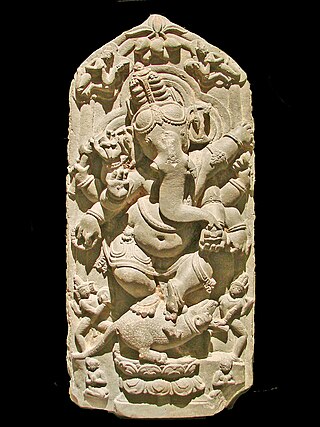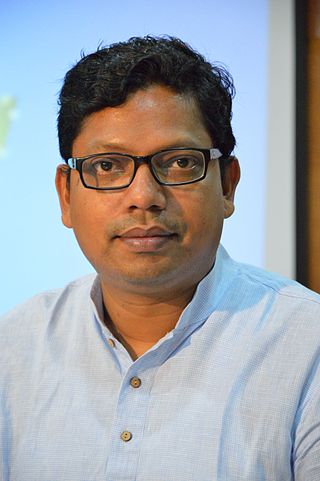
Rajshahi Division is one of the eight first-level administrative divisions of Bangladesh. It has an area of 18,174.4 square kilometres (7,017.2 sq mi) and a population at the 2011 Census of 18,484,858. Rajshahi Division consists of 8 districts, 70 Upazilas and 1,092 Unions.

Rajshahi is a metropolitan city and a major urban, commercial and educational centre of Bangladesh. It is also the administrative seat of the eponymous division and district. Located on the north bank of the Padma River, near the Bangladesh-India border, the city has a population of over 763,580 residents. The town is surrounded by the satellite towns of Nowhata and Katakhali, which together build an urban agglomeration of about 1 million population. Modern Rajshahi lies in the ancient region of Pundravardhana. The foundation of the city dates to 1634, according to epigraphic records at the mausoleum of Sufi saint Shah Makhdum. The area hosted a Dutch settlement in the 18th century. The Rajshahi municipality was constituted during the British Raj in 1876. It was a divisional capital of the Bengal Presidency.

The Padma is a major river in Bangladesh. It is the main distributary of the Ganges, flowing generally southeast for 356 kilometres (221 mi) to its confluence with the Meghna River near the Bay of Bengal. The city of Rajshahi is situated on the banks of the river. Since 1966, over 660 square kilometres (256 sq mi) of land has been lost due to erosion of the Padma.

Natore district is a district of Rajshahi Division located in northern Bangladesh. It borders the metropolitan city of Rajshahi, and used to be part of Rajshahi district.

Rajshahi District is a district in mid-western Bangladesh. It is a part of the Rajshahi Division. The metropolitan city of Rajshahi is in Rajshahi District.

North Bengal is a term used for the north-western part of Bangladesh and northern part of West Bengal. The Bangladesh part denotes the Rajshahi Division and Rangpur Division. Generally, it is the area lying west of Jamuna River and north of Padma River and includes the Barind Tract. The West Bengal part denotes Jalpaiguri Division and the Malda division together. The Bihar parts include the Kishanganj district. It also includes parts of Darjeeling Hills. Traditionally, the Ganga River divides Bengal into South Bengal and North Bengal, divided again into Terai and Dooars regions. Jalpesh and jatileswar are some of the most popular sacred places.

Rani Bhabani (1716–1803), also known as Ardhabangeshwari(অর্ধবঙ্গেশ্বরী) and Natorer Rani or the Queen of Natore, was a Hindu zamindar during the British colonial era in what is now Rajshahi, Bangladesh. She became the zamindar after the death of her husband Raja Ramkanta Moitra (Ray), 'Zamindar' of Natore estate. The Rajshahi Raj or Natore estate was a large zamindari which occupied a vast position of Bengal. The Natore estate had an area of nearly 34,000 square kilometres (13,000 sq mi) and included not only much of North Bengal but also large parts of the areas later comprising the administrative districts of Murshidabad, Nadia, Jessore, Birbhum and Burdwan. After the death of her husband, Rani Bhabani of Natore Rajbari, expanded both the estate and the palace.

The Bengali Brahmins are Hindu Brahmins who traditionally reside in the Bengal region of the Indian subcontinent, currently comprising the Indian state of West Bengal and the country of Bangladesh.
Sahibzada Mīrzā Mu'hammad Jalāl ud-Dīn Mridha Sahib, better known as Jalaluddin Mirza (1898–1975), was a Bengali Indian aristocrat in the erstwhile British Empire who served as the fifth and last hereditary Zamindar of Natore from the House of Singra and Natore before it was abolished in 1951.

The Uttara Ganabhaban is an 18th-century (1734) royal palace also known as Dighapatia Palace as it was formerly the seat of the Dighapatia Raj, an aristocratic landed estate in the East Bengal of India. It is a fine example of a jomidar bari. It was built by Raja Doyaram who was the Dewan (minister) of Rani Bhavanee. It has a round clock on its front gate with a large bell and a clock room. The clock was imported from Italy. It also has a beautiful garden full of various foreign trees and Italian marble stone statues of women. It is located near Natore town in North Bengal. It serves as the principal residence of the Bangladeshi Prime Minister in the northern part of the country. It has been used as a ceremonial site for receiving foreign ambassadors.
The Singranatore family is the consanguineous name given to a noble family in Rajshahi of landed aristocracy in erstwhile East Bengal and West Bengal that were prominent in the nineteenth century till the fall of the monarchy in India by Royal Assent in 1947 and subsequently abolished by the newly formed democratic Government of East Pakistan in 1950 by the State Acquisition Act.

Murari Chand College was the first college in the Sylhet Division. It was established in 1892, making it the seventh oldest college in Bangladesh. Since then it has played an important role in the educational, cultural, and political spheres of Greater Sylhet.

Varendra, also known as Barind, was a region of North Bengal, now mostly in Bangladesh and a little portion in the Indian state of West Bengal.

The Puthia Temple Complex consists of a cluster of notable old Hindu temples in Puthia Upazila, Rajshahi District, Bangladesh. Located 23 km to the east of Rajshahi city, it has the largest number of historic temples in Bangladesh. The temples were built by Hindu Zamindars Rajas of the Puthia Raj family who were noted philanthropists of Rajshahi. The temples have been built in terracotta in a variety of styles combining the typical Jor-bangla architecture with other influences. The Rajbari or Palace of the Raja of Puthia and the Dol Mancha are part of the complex. The temples are laid out around a lake with a sprawling lawn.

Rajanikanta Sen, also known as Kantakobi, was a Bengali poet and composer, known for his devotional (bhakti) compositions, as well as his patriotic songs.

Natore Rajbari was a prominent royal palace in Natore, Bangladesh. It was the residence and seat of the Rajshahi Raj family of zamindars. The famous queen Rani Bhabani lived here and after the death of her husband, expanded both the estate and the palace.

Dighapatia Raj was a zamindari in present-day Rajshahi, which was ruled by this dynasty of 7 generations of Rajas from early 18th century till the mid-20th century; when the democratic government took power after the end of the British Monarchy's rule in India, in 1950, the East Pakistan government abolished aristocracies and the zamindari system in present-day Bangladesh. The family was seated at the Dighapatia Palace.

Zunaid Ahmed Palak is a Bangladeshi politician, and the incumbent Member of Parliament from Natore-3.

Zamindars of Natore were influential aristocratic Bengali Zamindars, who owned large estates in what is today Natore District in Bangladesh .
Maharaja Jagadindra Nath Roy Bahadur (Moitra) known as the Maharaja of Natore was a noted zamindar of Natore from Bengal. He is also noted for his contribution to the game of cricket in British India.
















